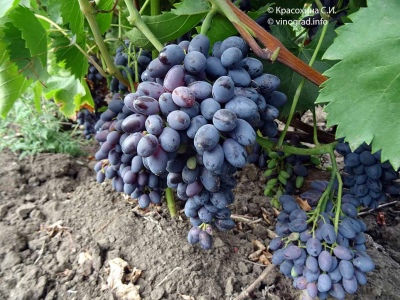
- Authors: Vierul, Moldova
- Appointment: dining room
- Berry color: black
- Taste: harmonious
- Ripening period: average
- Ripening period, days: 165
- Frost resistance, ° C: -27
- Bunch weight, g: 220
- Yield: 156 c / ha
- Flower type: bisexual
Dekabrskiy grapes are highly valued by many gardeners. They are attracted by unpretentious care, good survival rate, high yield. December has its pluses and minuses in comparison with other varieties.
Breeding history
The variety was bred by Moldovan breeders in 1961. The variety is obtained by crossing Villard Blanc and Korna Negra.
Description
The stems and buds are distinguished by a golden tint, the leaves are medium in size, three-lobed, have a dark green color. The vine is medium in terms of growth.
Ripening period
December refers to varieties with an average ripening period. You can eat berries after 165 days. Cleaning usually takes place in the last days of September.
Bunches
The bunches are characterized by an average density, their weight is about 220 g.
Berries
The fruits are black in color, the weight of each berry is 3-3.5 g, the size is 2.3x1.5 cm, the berries are quite dense on the bunch, they have 2-3 seeds.
Taste
The variety is characterized by a harmonious pleasant taste, the sugar content in the pulp is 148 g / dm³. Tasting score - 7.8 points. The pulp is juicy, the skin is dense, but when chewing is not felt.
Yield
The harvesting result is 156 c / ha, the fruiting factor is 1.4. Fruits begin to form in the third season after planting, and harvesting is possible in the fifth year of the bush's life. Each specimen is capable of producing 14-16 kg of fruit.


Growing features
When planting the December variety, consider the following factors:
most of all, this grape is suitable for growing in Moldova, in the North Caucasus, in the south of Ukraine;
the plant loves good lighting, so choose an area that is not shaded by other trees, it is important to avoid keeping in a draft;
the Dekabrskiy variety will thrive in soil with a high humus content.
Landing
Planting time is early spring or autumn. As a planting material, give preference to shoots with three or more roots - such a shoot adapts better. The planting process should look like this.
Dig a hole 80x80x80 cm in size, drive in a stake for support.
Form a drainage system at a level of 8-10 cm.
The next layer is well-moistened soil.
Add mineral fertilizer and organic matter, then add regular soil again.
Insert the planting material in the middle of the hole, straighten the roots, sprinkle with soil.
Seal the planting site and moisturize the area. Make sure that the neck of the root is not buried.
Add humus around the shoot as mulch.

Pollination
The flowers of this variety are bisexual, so no other pollinating varieties or insects are needed for breeding.
Pruning
Spring pruning is the removal of branches damaged during the winter. And also in the spring and autumn, formative pruning is carried out, accompanied by the tying of the shoots to the supports.
To improve the quality of fruiting, gardeners recommend pinching young plants a week before flowering. And also in the spring you can eliminate thin superficial roots - this process helps to strengthen the root system.

Watering
Young plants need regular moisture. During germination, mature trees are watered every two weeks, using 40-50 liters per bush. During the period of growth of the ovary, the culture requires moderate watering. Each irrigation process must be accompanied by loosening and removing weeds.


Top dressing
In early May, it is recommended to feed the plants with compost, mullein, ash, potassium and superphosphates. Give preference to liquid fertilizers. The vine is fed until the end of July.
Frost resistance and the need for shelter
The Dekabrskiy variety is able to withstand temperatures down to -27 degrees. If the bush is grown in the south, then you do not need to worry about the shelter. In the northern regions, it is worth protecting the plant from frost. To do this, remove the cut vines from the support and fold them into grooves, cover with agrofibre and cover with soil. Top with mulch. During the winter, make sure that the vines are always covered with a snowdrift.

Diseases and pests
The resistance of the variety to such common enemies of grapes as mildew, powdery mildew and gray rot is estimated at 2 points. The spider mite and leafworm are not interested in the December variety, but birds are fans of the berries. Despite the good immunity to insects and ailments, as a preventive measure, it is still worthwhile to systematically examine the bushes for signs of illness or pest damage.

If a grape is exposed to any disease or insect, this always affects its appearance.
Storage
One of the main advantages of the presented variety is its record long shelf life. The bunches retain their presentation for a long time, but they cannot boast of good transportability.











































































